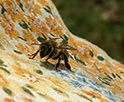Are Fireflies Endangered? Exploring the Decline of Bioluminescent Wonders
Why Are Fireflies Disappearing? Major Threats and Conservation Solutions
Reading time : 1 minute,
Discovery Chepe Id-753-ECO
Published in
06-16-2025

Photo: Josie Weiss
Fireflies, those tiny creatures that light up summer nights, have long captivated people with their glowing displays. But beyond their beauty, there is growing concern about the future of these insects. Are fireflies in danger of disappearing? Let' take a closer look at their conservation status, the threats they face, and what the future might hold.
Are fireflies at risk?
Fireflies are not officially listed as endangered globally, but several species are facing serious decline in many regions. For instance, in the United States and parts of Asia, scientists have observed a steady drop in firefly populations. Some specific species, like the Malaysian firefly (Pteroptyx tener), have seen their numbers dwindle due to habitat destruction. According to the International Union for Conservation of Nature (IUCN), while most firefly species have not yet been assessed, early signs point to trouble for these iconic insects.

The Plight of the Firefly: Habitat Loss, Pesticides, and Climate Change
What problems are threatening fireflies?
Several factors contribute to the decline of fireflies, many of them linked to human activity:
1- Habitat loss: The expansion of urban areas, deforestation, and wetland drainage have destroyed the natural habitats that fireflies need to thrive.
2- Light pollution: Artificial lighting disrupts the mating signals of fireflies, making it harder for them to find partners. This issue is especially serious in cities and suburbs.
3- Pesticides and pollution: Chemicals used in agriculture and other industries can be toxic to fireflies and the small organisms they feed on.
4- Climate change: Shifts in temperature and rainfall patterns can affect firefly life cycles and the ecosystems they depend on.
What is the outlook for fireflies?
The future of fireflies depends on the actions we take now. Conservation groups and scientists are working to protect key habitats and reduce light pollution. In fact, organizations like the Firefly Conservation & Research are raising awareness and providing guidance on how communities can help.
Some positive steps include:
a) Preserving wetlands, forests, and other natural habitats where fireflies breed and feed.
b) Using outdoor lighting that minimizes glare and directs light downward.
c) Reducing pesticide use and promoting organic farming practices.
Why should we care?
Fireflies are more than just a summer spectacle. They play a role in ecosystems by controlling pests and serving as indicators of environmental health. Their decline is a signal that something is out of balance in nature. By protecting fireflies, we are also protecting the broader biodiversity of our planet.
The glow of fireflies reminds us of the magic of nature. If we want future generations to enjoy these tiny beacons of light, we must act now to ensure their survival. Small changes in our habits can make a big difference. To learn more about how you can help, visit Xerces Society Firefly Conservation.
See Also
Discovery Chepe
Most read...















